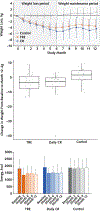Time-Restricted Eating Without Calorie Counting for Weight Loss in a Racially Diverse Population : A Randomized Controlled Trial
- PMID: 37364268
- PMCID: PMC11192144
- DOI: 10.7326/M23-0052
Time-Restricted Eating Without Calorie Counting for Weight Loss in a Racially Diverse Population : A Randomized Controlled Trial
Abstract
Background: Time-restricted eating (TRE), without calorie counting, has become a popular weight loss strategy, yet long-term randomized trials evaluating its efficacy are limited.
Objective: To determine whether TRE is more effective for weight control and cardiometabolic risk reduction compared with calorie restriction (CR) or control.
Design: 12-month randomized controlled trial. (ClinicalTrials.gov: NCT04692532).
Setting: University of Illinois Chicago from January 2021 to September 2022.
Participants: 90 adults with obesity.
Intervention: 8-hour TRE (eating between noon and 8:00 p.m. only, without calorie counting), CR (25% energy restriction daily), or control (eating over a period of 10 or more hours per day). Participants were not blinded.
Measurements: Change in body weight, metabolic markers, and energy intake by month 12.
Results: Seventy-seven persons completed the study. Mean age was 40 years (SD, 11), 33% were Black, and 46% were Hispanic. Mean reduction in energy intake was -425 kcal/d (SD, 531) for TRE and -405 kcal/d (SD, 712) for CR. Compared with the control group, weight loss by month 12 was -4.61 kg (95% CI, -7.37 to -1.85 kg; P ≤ 0.01) (-4.87% [CI, -7.61% to -2.13%]) for the TRE group and -5.42 kg (CI, -9.13 to -1.71 kg; P ≤ 0.01) (-5.30% [CI, -9.06% to -1.54%]) for the CR group, with no statistically significant difference between TRE and CR (0.81 kg [CI, -3.07 to 4.69 kg; P = 0.68]) (0.43% [CI, -3.48% to 4.34%]).
Limitation: Not blinded, not powered to detect relatively large differences in weight loss, and lack of adjustment for multiple comparisons.
Conclusion: Time-restricted eating is more effective in producing weight loss when compared with control but not more effective than CR in a racially diverse population.
Primary funding source: National Institutes of Health, National Institute of Diabetes and Digestive and Kidney Diseases.
Conflict of interest statement
Figures


Comment in
-
Time-Restricted Eating for Treatment of Obesity? The Devil Is in the (Counseling) Details.Ann Intern Med. 2023 Jul;176(7):999-1000. doi: 10.7326/M23-1396. Epub 2023 Jun 27. Ann Intern Med. 2023. PMID: 37364267 No abstract available.
-
Time-Restricted Eating for Weight Loss: The Jury Is Still Out.Gastroenterology. 2024 Mar;166(3):533. doi: 10.1053/j.gastro.2023.11.010. Epub 2023 Nov 8. Gastroenterology. 2024. PMID: 37949248 No abstract available.
-
Time-Restricted Eating Without Calorie Counting for Weight Loss in a Racially Diverse Population.Ann Intern Med. 2024 Jan;177(1):eL230445. doi: 10.7326/L23-0445. Ann Intern Med. 2024. PMID: 38224603 No abstract available.
-
Time-Restricted Eating Without Calorie Counting for Weight Loss in a Racially Diverse Population.Ann Intern Med. 2024 Jan;177(1):eL230446. doi: 10.7326/L23-0446. Ann Intern Med. 2024. PMID: 38224606 No abstract available.
References
-
- O’Connor A Fasting diets are gaining acceptance. The New York Times. 7 March 2016. Accessed at https://archive.nytimes.com/well.blogs.nytimes.com/2016/03/07/intermitte... on 29 March 2023.
Publication types
MeSH terms
Associated data
Grants and funding
LinkOut - more resources
Full Text Sources
Medical
